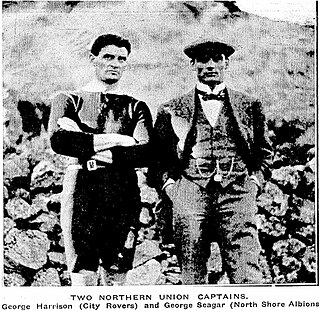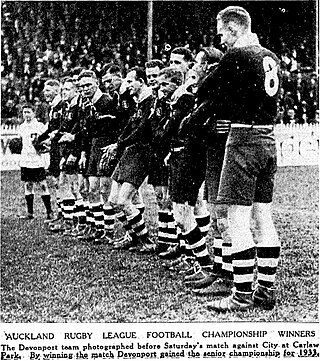
The Auckland Rugby League (ARL) is the governing body for the sport of rugby league in the Auckland Region of New Zealand including both club, school, and representative league.
The Auckland Rugby League competition has been competed for since 1909 when the first organised match was played between North Shore and City Rovers. The following year an official champion was crowned for the first time, namely the City Rovers club who won the 1910 1st Grade title and were one of the 4 original teams at that time. Over the following 110 years many team and individual trophies have been awarded. The following is a list of the clubs and individuals that they have been awarded to at the premier-grade level.

The 1912 Auckland Rugby League season was the 4th official year of the Auckland Rugby League. The season commenced on 11 May, with the start of the First Grade competition.
The 1913 Auckland Rugby League season was the 5th season of the Auckland Rugby league.
The 1914 season was the sixth season of Auckland Rugby League since its formation in 1909. It followed the 1913 Auckland Rugby League season where North Shore Albions were crowned senior champions for the first time. The senior grade saw the addition of Otahuhu Rovers, who had previously competed in the lower grades only, and Grafton Athletic. The Manukau Rovers and Eden Ramblers no longer contributed teams. The first grade was won once again by North Shore Albions.
The 1915 season, and 7th of Auckland Rugby League saw the First Grade competition begin on 8 May featuring the same 6 senior clubs who had competed in 1914.
The 1916 Auckland Rugby League season was the 8th year of the organisation.
The 1917 Auckland Rugby League season was its 9th. Due to the large number of players now serving in the First World War it was agreed to relax transfer rules to allow players from stronger teams to join weaker teams to even the competition. It was noted how many men from various clubs had been killed in battle by the beginning of 1917. They were Cecil Walker, Doug Dawson, T Marshall, Charles Savory, Frank McWhirter, Graham Cook, N Vause, V McCollum, Alf Gault, T Lambert, E Tiernan, F Stubbs, W. G. Handle, B Hart, F Gladding, A Powley, Chas Mann, William Moeki, G Jones, W Harris, S Magee, S Greer, Alan Miller, Charles Sinton, and Leslie O'Leary (Sunnyside). City Rovers had 'sent' ninety men to war by this time and twenty-one had been wounded and five killed. The Sunnyside club had only nine members left and one of those who had gone to the war said that in the trenches he had made a list of league players from various clubs which totalled 120. All three of the Sunnyside secretaries had enlisted and the executive was also gone. Ponsonby had also had over eighty of its members join the war effort.

The 1918 Auckland Rugby League season was its 10th since its inception in 1909. It was again severely affected by the ongoing war with several hundred players serving overseas and 44 killed who were named in the annual report. North Shore Albions withdrew from the competition early in the season and on other occasions teams played short-handed. There was also a truncated representative program with only a trial match and one full Auckland representative match versus Canterbury, which was played at the Auckland Domain in front of 10,000 spectators.
The 1919 season of the Auckland Rugby League was its 11th. It was the first season post World War I and unsurprisingly it saw a resurgence in playing numbers with 56 teams across the six grades. North Shore Albions who had previously dropped out of the senior competition again fielded a senior side. As did Otahuhu, who had dropped out during the 1917 season. Ponsonby United won their third consecutive first grade title, while Newton Rangers won the Roope Rooster trophy.
The 1930 season of Auckland Rugby League was its 22nd. It was generally regarded that the season was very disappointing in terms of the quality of the football played and much of the blame was put down to the fact that too many teams were in the Senior A Grade and there was too much talent spread through the Senior B teams which in turn diluted the top division. There had been a noticeable drop in the attendances at matches at Carlaw Park which had seen 8 to 10 thousand regularly attending club matches. A review of the season was published in The New Zealand Herald on 22 October discussing the issue.
The 1932 season was the 24th season of the Auckland Rugby League.

The 1933 season of Auckland Rugby League was its 25th. The championship was won by Devonport United. This was their fifth title having previously won it in 1913, 1914, 1928 and 1932. The first two titles were prior to their merger with the nearby Sunnyside club when they were known as North Shore Albions, a name they later reverted to. They finished 1 point ahead of runner up Marist Old Boys. Devonport also won the Stormont Shield for the third time following victories in 1930 and 1931. They defeated Richmond Rovers in the final by 12 points to 7. Richmond had gained their place in the Stormont Shield match by winning the Roope Rooster with wins over Newton (29–15), Marist Old Boys (10–0), and City Rovers in the final by 26 points to 14. This was Richmond's third Roope Rooster title following wins in 1926 and 1927. Marist were awarded the Thistle Cup for the most competition points scored in the second round.
The 1936 Auckland Rugby League season was its 28th. The Fox Memorial was won by Manukau in their first season back in the senior A grade as a stand-alone club since the early 1910s. They also won the Roope Rooster competition when they defeated City Rovers 23 to 10 in the final. Richmond Rovers finished runners up in the Fox Memorial and earned the right to play Manukau for the Stormont Shield. Richmond won the trophy after beating Manukau 30–9 in the Stormont Shield clash. Richmond also won the Phelan Shield after they had been knocked out of the Roope Rooster in the first round. They beat Marist Old Boys 13–9 in the final.
The 1938 Auckland Rugby League season was its 30th. Marist Old Boys won their 3rd first grade title with their previous coming in 1924 and 1931.
The 1939 Auckland Rugby League season was its 31st.
The 1940 Auckland Rugby League season was its 32nd.

North Shore Albions won the Fox Memorial Shield for the 6th time since their formation in 1909. Their previous titles were in 1913, 1914, 1928, 1932, and 1933. This was to be their last first grade championship title. They finished with a 13 win, 1 draw, 2 loss record for 27 competition points, just one competition point ahead of Manukau. Both teams were well out in front in the title race with Richmond Rovers in 3rd, 8 points behind Manukau.
The 1945 Auckland Rugby League season was its 37th. Ōtāhuhu Rovers achieved several milestones in the 1945 season. They won the Rukutai Shield for the second time but the first as a stand-alone club with their win in 1942 season coming as a combined side with City Rovers due to senior teams being depleted by the war effort. They won it by earning the most competition points during the first round. Ōtāhuhu went on to win the minor championship for the first time when they finished 1 competition point ahead of the Richmond Rovers. In a somewhat confusing format the top 4 teams then played off for the major championship. Ōtāhuhu were defeated in the semi final by Ponsonby United, who then lost the final to Richmond. The league then declared that Ōtāhuhu as minor champions and Richmond as 'major' champions should play off to find the major champion for the season. Ōtāhuhu won 11–5 to become the official senior club champion for the 1945 season. At a meeting on September 26 several delegates “expressed the opinion that the minor and major competitions had been a muddle and more consideration should be given to them next season”. With chairman Watson saying a conference would be arranged for a “more definite policy after consultations with all senior clubs”. The Dickson medal for the most sportsmanlike player was awarded to Jim Fogarty of the Ōtāhuhu side, while V. Fredatovich won the same for the City 3rd grade team. Brian Nordgren set a record for the most number of points scored in a season in all games and was presented with a silver cup. At the same time Colin Riley (Ōtāhuhu) was presented with the Painter Trophy for the most successful goal kicker.
The Telegraph Messengers Club was a rugby league club in Auckland, New Zealand which existed from 1916 to 1919. They competed in the Auckland Rugby League lower grade competitions. They were initially affiliated to the Ponsonby United club before amalgamating with the Maritime Football Club during the 1920 season. They were composed of telegraph messengers for the Post and Telegraph organisation hence their name.





